Paris Costumes the Brides with Originality - 1922
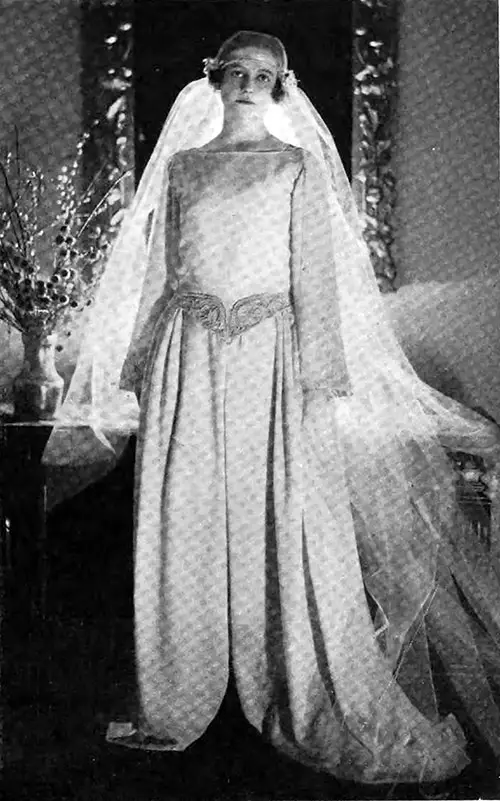
Mlle. Marguerite de Montgolfier, Bride of Baron Roger de Longuerue, Wears a Gown of Chiffon Velvet Over Silver and a Draped Tulle Veil. Photograph by Dorys, Paris. Vogue Magazine, 1 April 1922. GGA Image ID # 15f21c27af
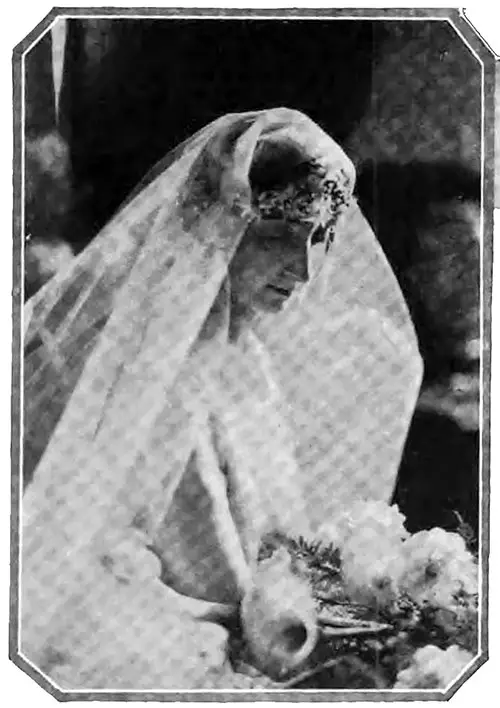
At Her Wedding to the Count de Leusse, Mlle. Kulp Shaped Her Crown of Orange-Blossoms to the Form of a Diadem. Photograph by Dorys, Paris. Vogue Magazine, 1 April 1922. GGA Image ID # 15f24049da
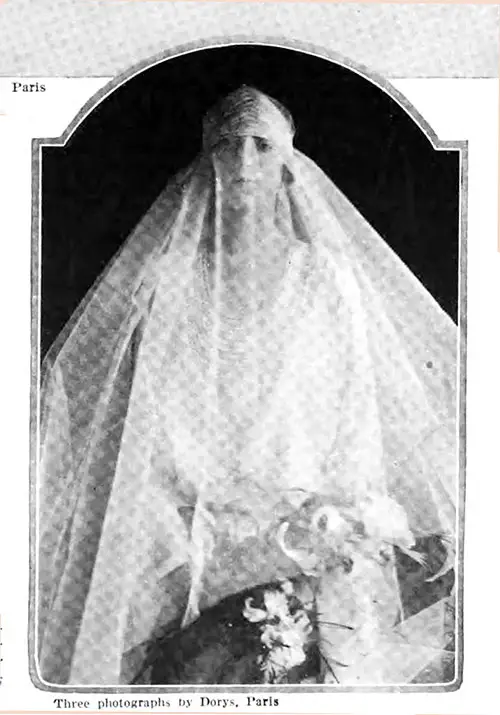
Mlle. Baudry, the Bride of M.Jean Besnard, Abandons Orange Blossoms and Chooses in Their Place a Cacochnik of Pearls. Photograph by Dorys, Paris. Vogue Magaine, 1 April 1922. GGA Image ID # 15f2a1467b
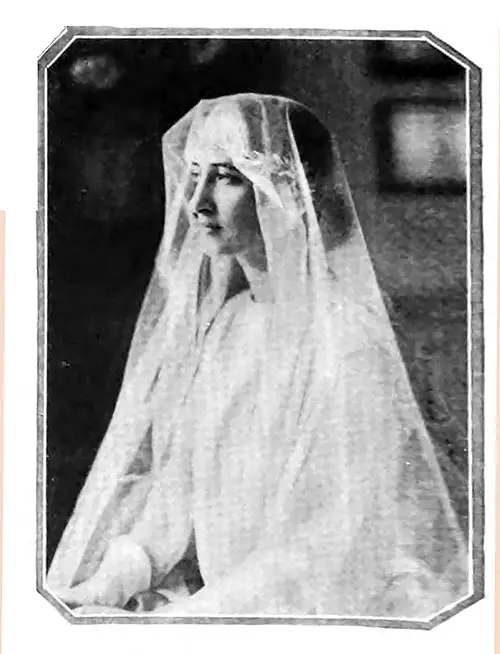
The Wedding Coiffure of Today Scorns Tradition and Seeks Individuality. Thus Mlle. Gisele Cahen-Fuzier Completes Her Botticelli Gown With a Veil of Florentine Draping and a Crown of Silver Laurel Leaves. Vogue Magazine, 1 April 1922. GGA Image ID # 15f3053034
Recent weeks in Paris have witnessed a series of distinguished weddings, and some of the wedding gowns, as well as frocks from certain notable trousseaux are sketched on these two pages.
In these wedding costumes, one notes a new tendency in the coiffure, a tendency to shape the familiar crown of orange-blossoms into a diadem, not a mere fillet of flowers, such as has been seen before, but a true diadem of the very shape of those diadems of brilliants made by Cartier or Chaumet, which these brides will wear a few weeks after their weddings.
It is interesting to note, however, that this novelty in the coiffure is adopted or rejected by the independent young things of today according to its becomingness. Many young faces find other arrangements more in accord with their lines and choose a novelty of a different order, as in the case of Mademoiselle Pepin Lechalleur, who adopts an eighteenth-century shepherdess arrangement, which leaves the forehead bare and throws the veil of appliqué lace back over the hair.
Custom has greatly changed in France since the days when a young girl appeared in society only a few months before her marriage and when she was considered as having no right to either a decision or an opinion regarding her trousseau. Had she any voice in the choice of her husband? That is a point which in many cases remains obscure. At all events, this timid and charming child had to submit, with regards to the selection of wedding gown, linen, and all of the trousseau, to the decision of a family, which perhaps, does not know at all her taste or her ideas.
“Chaque age a ses plaisirs,” says an old proverb, but every age also has its view of life and its personality, and how could any trousseau hope for success when it failed in a thousand details to accord with the tastes of the young girl for whom it was made. Many young women of those days, women neither eccentric not foolish, would put their trousseaux aside and never touch them from the day of their wedding, for the simple reason that they had not had a word to say in their selection.
Happily, all that is changed today, and while the modern mother accompanies her daughter to the houses which she considers best suited to meeting her trousseau needs, she leaves the fiancée free to choose her own styles and fabrics. Thus the young wife of today finds pleasure in wearing or using such things as she has had made for her— a moderate supply, however, for it should be noted that it is no longer the custom to prepare the immense trousseaux of our mothers time.
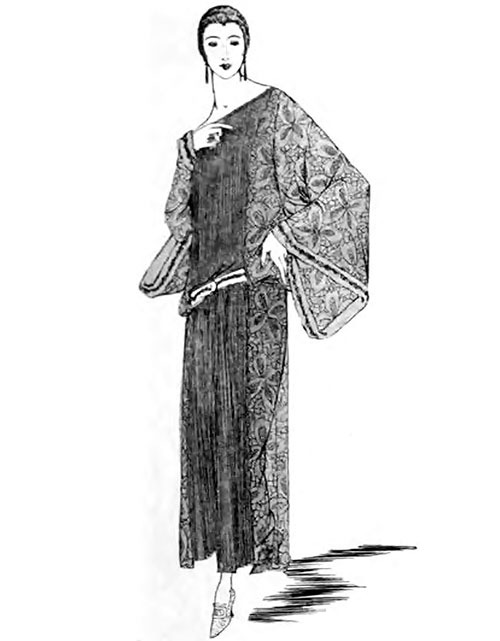
From Rust Crepe de Chine and Matching Lace, With Bands of Grey Fur, Worth Creates a Graceful Robe D'Interieur for the Trousseau of Mlle. Odette Trézel. Vogue Magazine, 1 April 1922. GGA Image ID # 15f33fd7dc
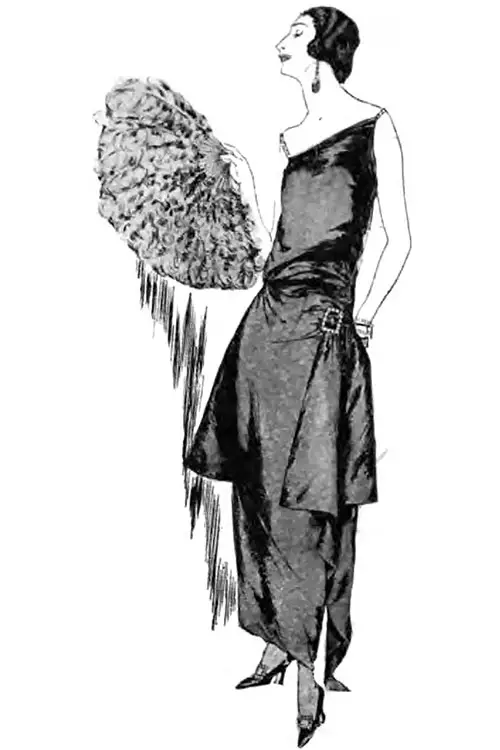
For Wear at Small Informal Dinners, Mlle. Trézel Includes in Her Trousseau This Paton Gown of Very Shiny Black Satin, Draped and Held by a Buckle of Strass. Vogue Magazine, 1 April 1922. GGA Image ID # 15f341fb82
It has gone out of fashion that old love of linen-closets stored with dozens upon dozens of sheets and every other conceivable variety of household linen. The modern bride prefers fewer pieces and more beautiful ones, with hand-made lace and openwork. The same thing is true to an even greater extent of frocks.
The young girl now prefers to include only a modest number of frocks in her trousseau and to wait until a little while after her marriage and then select toilettes which will please her in her new role, frocks which will accord with the different tastes which come with her new life and her greater independence.
A very important feature of the wedding costume itself is the coiffure and, in this matter also, the brides of today are seeking to avoid the traditional, and adopt the individual and becoming. Thus Mademoiselle Baudry chose on the occasion of her marriage to Monsieur Jean Besnard, to wear over the traditional tulle veil, a Russian diadem of opaque pearls which matched the embroidery on her sleeves and on the low-cut gown, giving much distinction to the costume.
Not less original and equally successful was the wedding costume which Mademoiselle Cahen-Fuzier wore with such grace. Her gown was of a very heavy white velvet, and a wide, heavy girdle of pearls and passementerie fell down the middle of the front to the edge of the skirt, which just touched the floor. Not less charming was the unusual coiffure adopted by Mademoiselle Cahen-Fuzier. The hair was knotted low at the back, leaving the forehead bare, and a crown of silver laurel leaves held the tulle veil.
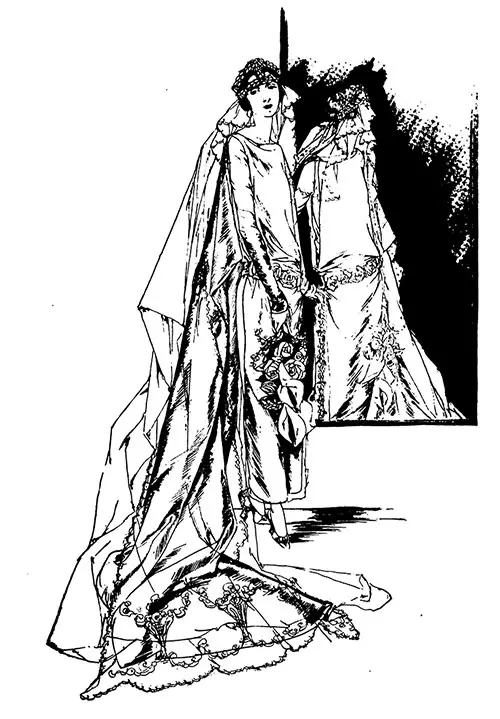
The Coiffure of Mlle. Odette Trézel, Whose Wedding to the Count de Zogheb Was One of the Recent Social Events in Paris, Adopted the Fashion Much in Favor With Paris Brides Today of Wreathing the Orange-Blossoms Into a Diadem. Her Worth Gown Was an Exquisite Model of Silver Cloth Veiled With Tulle and Girdled With Camellias. Vogue Magazine, 1 April 1922. GGA Image ID # 15f3915684
Mademoiselle de Villa-Urrutia, who has such admirable taste in frocks, and whose costumes, as well as those of her charmingly youthful mother, have often been sketched for Vogue, had a wedding costume of originality and beauty. A diadem of orange-blossoms, rising to a high point and very becoming to her delicate brunette face, held the veil of a rare and lovely point d'Angleterre, and her dress was of silver cloth, made with short sleeves.
On the whole, the modern bride presents an entirely new conception of the wedding costume and one which carries us farther and farther from the traditionally virginal wedding which, a scant ten years ago, was still but a slight variation of the communion gown. At present, the reaction is extreme, but who should complain of that, in a world which wants everything changed at least every two years.
These young girls who have decided that the important thing is to choose a coiffure which is becoming and suited to their type, who have set the mode aside and selected the arrangement which befits the individual, instead of merely putting themselves in the hands of the mother's coiffeur, however, skilled those hands may be.
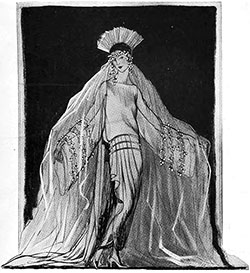
Slim and Lovely in Its White Satin Simplicity, This Wedding Gown Is Adorned by Rows of Pearls at the Low Waistline and Delicate Embroidery of Seed Pearls and Orange-Blossoms on the Tulle Sleeves. a Bandeau of Orange-Blossoms and a Piquant Fan Effect at the Head Are Unusual Features of the Veil – Wedding Gown From Hudson. Vogue Magazine, 1 April 1922. | GGA Image ID # 15f3bc4ed2
EXQUISITE IS THE ‘WEDDING GOWN THAT COMBINES EMBROIDERED SLEEVES, A LOW-PLACED GIRDLE OF PEARLS, AND NEW SIDE DRAPERIES.
To this expression of individuality, we owe a whole series of wedding coiffures as delightful as they are different which range from the cacochnik of pearls to the wreath and veil that suggest the modes of the Renaissance.
In other ways, too, one sees the effect of this independence of youth, and it is to this same expression of personality that we owe the many new ideas for the arrangement of the new home, so different from those of an earlier day. Today, both young girls and young men mingle far more in the family life in their own homes and are not sent away for such long periods to distant schools.
Under the old order, a boy of eighteen came from school still hardly more than a child and with little realization of his own personality, whereas, at the present time, reading, travel, and the studies in the art so usual in the education of modern youth, make every child, boy or girl, a friend, and comrade for the father or mother however much older.
In furnishing the new home, it is rarely that the young married people of today select the entire furnishings at once. With the more and more marked taste for individual and antique pieces, they are naturally inclined to take the longer time which may be required to find, by careful search or in the course of journeys, the pieces which it will give them a real pleasure to possess.
They take an apartment and install there the essentials of living, while the more formal rooms are left for more gradual furnishing. Many young married women receive in the boudoir, where flowers, admirable taste, and the atmosphere which they know how to create make a room of such charm that one regrets to have the more formal rooms completed.
For the marriage of Mademoiselle Trézel to the Count Henri de Zogheb, Worth, Chéruit, Paton, and other noted houses created a trousseau of great beauty. Very lovely was the bride under her diadem of orange-blossoms, set high on the head somewhat
in the manner of that worn by Mademoiselle de Villa-Urrutia, a fashion which has gained great favor in the last few months.
For the wedding gown, Worth designed a long sheath gown of silver cloth, so supple and clinging that the slender bride seemed like a lily on its slim stem, veiled with a mist of tulle and appliqué embroidery.
A TROUSSEAU OF SIMPLICITY
The gowns which Mademoiselle Trézel chose for her trousseau are all simple, for no others could suit so well her type of beauty. The Count de Zogheb belongs to one of the notable and very wealthy families of Alexandria, and many social functions have been given in connection with the wedding.
The jewels of the Countess de Zogheb are of great beauty, especially the diadem with its pendants of pearls and diamonds, an immense emerald in an antique setting of diamonds, and magnificent pearls, which will doubtless be among the beautiful jewels to be seen at the Opera and at evening functions this spring during the Paris season.
Although many members of the social world are not yet back in Paris, there are many less formal functions, and teas are very smart at the moment. The smartest of these teas gather together well-known writers and artists, who give to the occasion a
more interesting character than the feminine teas where attention is devoted to fashions.
The Countess de Castries is hostess at many of these teas, and The Princess Marthe Bibesco, a poet of rare gift, is often among the guests, charming all the world with her brilliance and her beauty. On a recent afternoon, she was dressed all in grey, from the tips of her toes to the top of a toque which suggested an Indian turban, and she wore a little half-veil which emphasized the firm contour of her face and the full, yet decisive lips. Her eyes have the beauty of the Orient, for this Princess is a Roumanian, a native of that land where poetry is at home both at the court and in the hut.
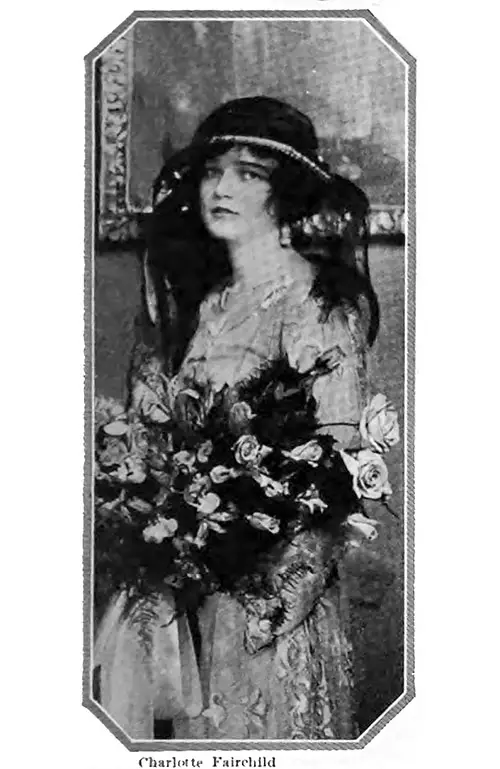
At a Smart Wedding Recently, the Bridesmaids Wore Frocks of Apricot Lace With a Large Design, Which Was Draped at One Side So That the Scalloped Border Fell in a Deep Point Almost Touching the Floor. Miss Martha Ottley Was One of the Bridesmaids for Mrs. Charles Coulter, Formerly Miss Helen Trevor. Modeled by Charlotte Fairchild. Vogue Magazine, 1 April 1922. GGA Image ID # 15f3f34b7a
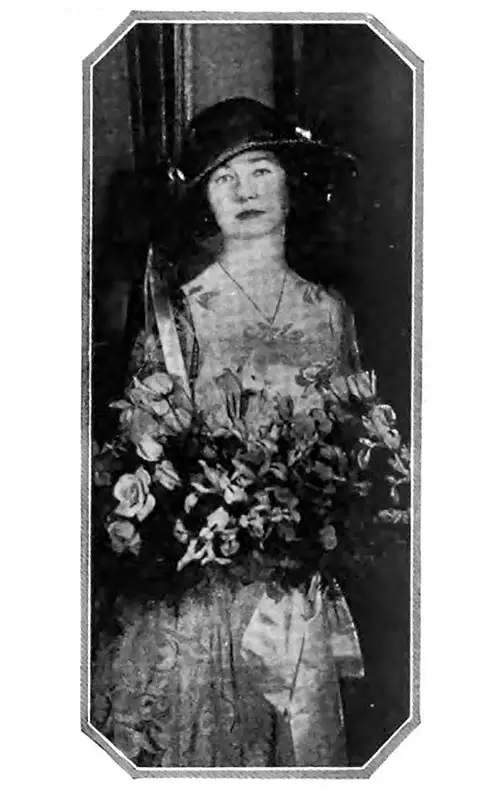
The Pastel Shades, Dear to the Mode, Made an Effective Color Scheme. the Bridesmaids, of Whom Miss Eleanor Parrish Was One, Carried Ophelia Roses and Blue Iris; Their Apricot Frocks Were Sashed With Lark Spur Blue, and Their Drooping Brown Lace Hats Were Trimmed With the Same Shade of Blue Ribbon. Vogue Magazine, 1 April 1922. GGA Image ID # 15f3fb65be
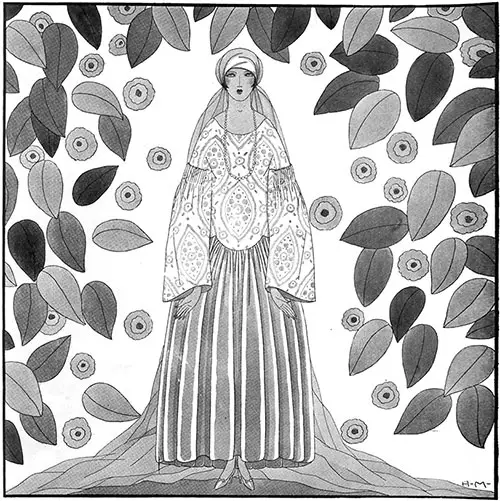
Past and Present Meet in the Brocade and Silver Cloth of This Beautiful Wedding Gown Designed by Poiret Especially for the Marriage of His Niece. the Long-Waisted Bodice of Silver Brocade Falls Over the Full, Gathered Skirt of Silver Cloth in Rounded Points Both in the Front and the Back; The Sleeves Display a Delightful Originality in Being Shirred to a Deep Shoulder-Line and East Meets West When the Occidental Bride Winds the Long Tulle Veil Into a Turban About Her Head. There Is No Train. Vogue Magazine, 1 April 1922. GGA Image ID # 15f4240f8e
OUT OF THE SHIMMER OF BROCADE AND THE SPARKLE OF SILVER CLOTH, PAUL POIRET HAS CREATED FOR THE APRIL BRIDE A WEDDING GOWN WHICH HAS CAUGHT THE IRIDESCENCE OF WAVES BREAKING INTO SPRAY IN SUNLIGHT
"Paris Costumes The Bride With Originality," in Vogue, New York: The Vogue Company, Vol. 59, No. 7, 1 April 1922, pp. 52-55.
